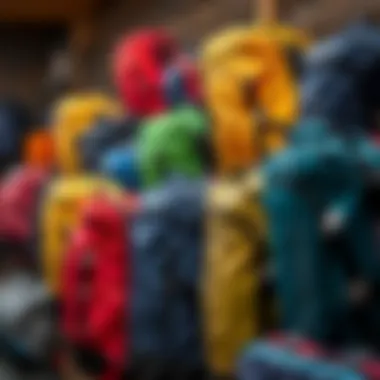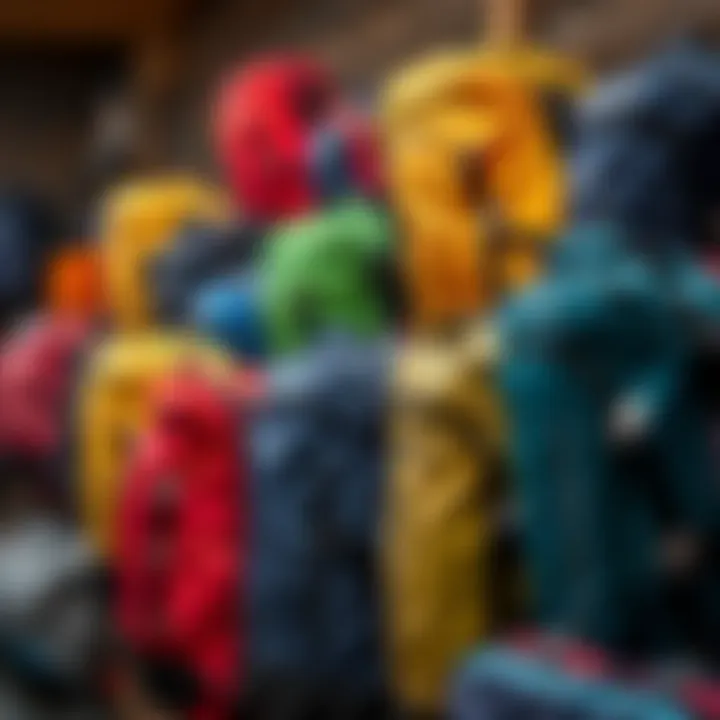Dakine Bags: Essential Gear for Kiteboarding


Intro
Kiteboarding is not just a sport; it's a lifestyle that pulls people into the wind and waves, allowing them to embrace adventure like a moth to a flame. Among the key components of this exhilarating experience is the right gear, particularly when it comes to storage and transportation. That's where Dakine bags come into play, offering durability and style for kiteboarding enthusiasts.
These bags are engineered with both functionality and the unique demands of kiteboarding in mind. From spacious kite bags to specialized accessories that keep everything organized and protected, Dakine has carved a niche that stands out in the crowded marketplace of outdoor gear.
This article will take a comprehensive look at Dakine bags, covering various models, the materials they’re made from, and how they stack up against other brands. By the end, it will be clear why Dakine is often the first choice for kiteboarders who prioritize quality and performance.
Let’s dive into the essential gear that kiteboarders need, starting with the crucial gear and equipment.
Prelude to Dakine Bags
When you're out on the water, whether aiming to catch a wave or mastering a new kiteboarding trick, having the right gear at your fingertips is paramount. This is where Dakine bags come into play, becoming not just containers, but essential companions for every kiteboarding enthusiast.
Dakine, known for its rugged build and functional designs, offers a wide range of bags tailored to meet the specific demands of adventure seekers. Whether you are a seasoned pro or just starting your kiteboarding journey, understanding why Dakine bags may be the optimal choice can enhance your experience on the water.
Functionality and Features
One of the standout features of Dakine bags is their versatility. Designed with the active kiteboarder in mind, these bags often incorporate specialized compartments to accommodate gear like boards, kites, and harnesses. Plus, many models include cushioned straps and ergonomic designs, ensuring comfort during transport, which can mean the difference between a breeze and a strain.
Durability You Can Trust
Dakine's commitment to using durable materials plays a crucial role in their popularity. Many of their bags are crafted from heavy-duty fabrics that resist tearing and water damage. This durability ensures that, even in rough conditions, your gear remains safe and protected. Considering the exposure to sand, salt, and other elements, this aspect is not something to overlook.
"Dakine doesn't just sell bags; they offer peace of mind for every kiteboarding outing."
Reflecting on Relevance
In the kiteboarding community, choosing the right bag is not just about style; it's about practicality and safety for your equipment. As kiteboarding continues to grow as a sport, understanding the advantages that a reputable brand like Dakine provides can lead to better decisions regarding gear management. Overall, Dakine bags represent a blend of functionality, durability, and thoughtful design that makes them worthy of consideration for any dedicated kiteboarder.
As we delve deeper into the specifics of Dakine bags, keep in mind the interplay of functionality and aesthetics, durability, and tailored designs that cater to the unique needs of those on the water. By the time we reach the conclusion, you should have a clear perspective on why Dakine could be the right fit for your kiteboarding escapades.
History and Brand Evolution
The journey of Dakine bags is as thrilling as a kiteboarding adventure itself. Understanding the brand's history provides deep insight into its prominent position within the kiteboarding community. It's not just about the bags' physical attributes; it's about the legacy they carry and the passion that fuels their design and innovation. Recognizing these key elements helps kiteboarding enthusiasts appreciate the roots and growth of Dakine, as well as the thoughtful attention to users' needs.
Foundation of Dakine
Dakine originated in 1979, stemming from a simple idea sown in the surf and snowboard culture of Hawaii. The founder, Rob Kaplan, aimed to create gear that could withstand the rigors of intense outdoor sports. The brand name itself, Dakine, is a Hawaiian slang term meaning “the best.” From the get-go, the intention was clear: produce bags and accessories not just for style, but for the ultimate functionality in extreme conditions.
With a focus on quality and performance, Dakine quickly became synonymous with durability and innovation. The earliest products were crafted in a small, makeshift operation, fueled by passion and the spirit of adventure. As word spread among surfers, snowboarders, and later kiteboarders, the demand grew steadily. This foundation paved the way for Dakine to evolve from a local brand into a globally recognized name in extreme sports equipment. The roots run deep, and the connection to the wave-riding community continues to shape their offerings.
Growth Through Innovation
As the years rolled on, Dakine flourished, constantly adapting to the demands of both the market and the enthusiasts it served. Diversification became crucial. With kiteboarding gaining traction in the late '90s and early 2000s, Dakine shifted gears to meet the needs of this emerging sport. The brand didn't just sit back and watch; they jumped in feet first, devising specific bags designed to protect gear and enhance portability.
Innovation was not just a buzzword; it was a commitment. Dakine invested heavily in research, testing materials, designs, and functionalities. This quest for excellence has led to unique features that set Dakine bags apart from competitors. Kiteboarders, for example, benefit from specialized compartments that adhere to the specific gear they carry, whether it’s boards, harnesses, or safety equipment.
The emphasis on bold colors and stylish designs also guarantees that enthusiasts can express their individuality while maintaining utility. Dakine continues to listen to user feedback and adjust their products accordingly; hence, maintaining a cycle of continual improvement and adaptation.
By embracing innovation while being anchored in their Hawaiian origins, Dakine has managed to grow into a beloved choice for many outdoor sports fans, especially kiteboarders. The combination of their rich history and forward-thinking approach has made them a pioneering force in the realm of outdoor gear.
“In the world of kiteboarding, where every moment counts, Dakine’s commitment to quality ensures that enthusiasts can focus on riding the waves, not worrying about their gear.”
Through this historical lens, we get an understanding of not only how Dakine rose to prominence, but the reasons why their bags are thus well-suited for kiteboarding: rooted in passion, fortified by innovation, and designed with the user in mind.
Design Philosophy of Dakine Bags
The design philosophy behind Dakine bags plays a crucial role in their reputation and effectiveness for kiteboarding enthusiasts. It's not just about having a bag; it’s about functionality infused with thoughtful aesthetics that meet the challenging demands of the sport. In a fast-paced environment, athletes require gear that not only looks good but also performs under duress. Every curve, every pocket, every stitch is made with potential users in mind, making these bags an essential piece of equipment rather than mere accessories.
Functionality Meets Aesthetics
In the world of kiteboarding, functionality is king, but aesthetics are the icing on the cake. Dakine bags strike a balance between the two, creating products that don’t just serve a purpose but do so with flair. Take the Dakine Mission Pack, for instance. It’s thoughtfully sculpted to carry all essential gear while providing comfort and style. With features like padded straps and various compartments, it exemplifies how efficiency can dance with design.
- Utility First: Dakine incorporates elements that cater specifically to the needs of kiteboarders. Waterproof compartments for storing wet gear and easy-access pockets for quick retrieval of necessities create a user-friendly experience.
- Visual Appeal: The surf culture inherently values aesthetics, and Dakine recognizes this by offering vibrant colors and stylish patterns that appeal to riders who want to look good while pirouetting over waves.
"In essence, it's like art that meets engineering. The design embodies the spirit of adventure and the practicality demanded by a lifestyle on the water."
Customization Options
Customization goes a long way in helping kiteboarders feel connected to their gear. The ability to choose from a variety of designs, colors, and additional accessories not only creates a sense of personal ownership but also enhances functionality. Dakine provides options that allow users to tailor bags to their specific needs.


- Personalized Graphics: Customers can select patterns or prints that reflect personal style, ensuring that each bag feels unique.
- Accessory Choices: From detachable compartments to extra straps, Dakine has made it effortless to adapt bags to varying day-to-day requirements.
Customization reflects a deeper understanding of kiteboarding culture where individuality is celebrated. Riders often want gear that represents their journey, and with Dakine, that’s not just possible; it’s encouraged.
By focusing on both functionality and customization, Dakine bags cater to those who seek adventure. This marriage of form and function solidifies Dakine as not just a brand, but a companion for every kiteboarder's quest.
Material Composition
When delving into the effectiveness and reliability of Dakine bags, the material composition stands front and center. A well-rounded understanding of the fabrics and materials used not only highlights the bags’ capability to withstand the rigors of kiteboarding but also ensures that enthusiasts are making an informed choice. The focus on material composition allows for a deeper appreciation of the intricate balance between functionality and sustainability, both critical for the demands of outdoor adventures.
Durability of Fabrics
Durability is a mainstay concern for anyone who uses gear in harsh conditions, especially for kiteboarding lovers who face wind, water, and sand on every trip. Dakine has chosen materials like polyester and nylon for their strength and longevity. These fabrics have been engineered to resist tearing, puncturing, and fading, which can be essential over time.
These choices often stem from rigorous testing in real-world conditions. For instance, a common feature in many Dakine bags is the 1680D ballistic nylon, which boasts exceptional abrasion resistance. Compared to standard materials, this tough fabric can take a licking and keep on ticking, ensuring that your valuables stay safe and sound no matter where your adventures take you.
Many users recommend checking the fabric denier rating since higher numbers indicate thicker fibers. Additionally, reinforced stitching often takes durability a step further, preventing seams from ripping apart when the bag is overloaded with gear. In the heat of a kiteboarding session or amid a sudden rainstorm, the last thing you need is gear failure, and that's where Dakine's careful consideration of fabric comes into play.
Eco-Friendly Initiatives
In today's world, the call for sustainability draws sharper every year. Many brands, including Dakine, have sought to introduce eco-friendly materials into their product lineup. Among these initiatives, the use of recycled materials is perhaps the most noteworthy. Bags made from recycled PET (rPET) significantly reduce the carbon footprint and divert plastic waste from landfills.
For kiteboarders keen on preserving beach sanctuaries and waterways, Dakine’s effort in making bags that are kinder to the environment resonates. They aim to maintain durability while being conscious of environmental impact – a worthy balance that could shape a new era in outdoor gear production.
While details can ebb and flow over time, an interesting angle lies in how consumers perceive brands when they make such efforts. Shoppers are increasingly likely to favor brands that align with their values, thus fostering a sense of loyalty alongside commitment to the sport.
"Choosing gear that's safe for the Earth does more than just protect what we love; it shows we care about the future of kiteboarding and outdoor sports."
Ultimately, understanding the interplay of durability and eco-consciousness in Dakine bags provides kiteboarding enthusiasts with a selection that respects their adventurous spirit and the planet they traverse.
Product Range: Types of Dakine Bags
When it comes to kiteboarding, having the right gear storage is just as essential as the kite itself. Dakine offers an impressive range of bags tailored for the kiteboarding enthusiast, encompassing functionality, protection, and convenience. This variety ensures that whether one is out on the water or heading off on a trip, there is a reliable option to suit their needs. Let's take a closer look at the different types of Dakine bags that cater specifically to kiteboarders.
Backpacks for Kiteboarding
Dakine backpacks are not just about carrying essentials; they are designed with the active lifestyle of a kiteboarder in mind. These bags often feature padded straps and back panels that hug your body comfortably, making long treks to the beach much easier. With designated compartments for items like a wetsuit, sunscreen, and even the occasional snack, these backpacks keep everything organized and easily accessible.
- Hydration Feature: Many Dakine backpacks come equipped with a hydration reservoir pocket. This thoughtful addition encourages kiteboarders to stay hydrated in the sun.
- Water-Resistant Material: The outer fabric is often crafted to withstand splashes or unexpected rain, protecting your gear inside.
Overall, the backpacks serve as a multi-functional bag that balances organization and comfort. They offer the necessary space for on-the-water essentials while remaining compact enough to avoid becoming a burden.
Duffle Bags for Travel
Duffle bags are another integral part of the Dakine lineup. They stand out for their spacious design, making them ideal for longer trips and easy packing. Kiteboarders can easily stow larger items such as boards and kites, and the variety of compartments means you can separate your wet gear from the dry. This type of bag simplifies travel logistics, especially when you're shuttling to various kite spots.
- Sturdy Handles and Straps: Duffle bags are built with reinforced stitching and strong handles, ensuring they can carry heavier loads without risk of tearing.
- Versatile Design: Whether you are flying to a tropical location or driving to a local beach, the ample room in a Dakine duffle means you can pack everything you need for an adventure.
Choosing a duffle bag from Dakine provides a blend of practicality and durability, crucial for kiteboarding trips where you need to trust your gear under all conditions.
Board Bags and Protective Gear
Lastly, protective gear bags are essential for any serious kiteboarder looking to keep their board in pristine condition. Dakine offers a variety of board bags that cater to different board sizes and styles. These bags often feature padded interiors to absorb shocks and prevent scratches, crucial during travel.
- Lightweight and Sturdy: Unlike some alternatives that can be cumbersome, Dakine's board bags strike a balance between weight and sufficient protection.
- Easy Access: They often include zippers that open wide, making it a breeze to store or retrieve your board.
Key Features That Stand Out
In the realm of kiteboarding, the right gear can make a world of difference. Dakine bags are not just carriers for equipment; they are meticulously designed to enhance storage solutions, provide comfort, and withstand the elements. This section explores the key features that set Dakine bags apart, emphasizing their utility and relevance for those who live and breathe kiteboarding.
Water Resistance
When you’re out conquering the waves, the last thing you want is wet gear. Dakine bags are engineered for water resistance, which is a non-negotiable feature for any kiteboarder. The fabrics used repel water effectively, ensuring that whether it’s a splash from a wave or an unexpected rain shower, your equipment remains dry.
- Why It Matters: The integrity of your gear largely depends on the conditions it faces. Kiteboarding often involves water and wind, so the ability to keep your essentials safe from moisture is crucial. Equipment like kites, boards, and harnesses perform best when they’re not soggy.
- Materials Involved: Dakine often uses high-grade materials treated with water-resistant coatings. This helps in prolonging the lifespan of the gear housed inside, which ultimately translates to better performance on the water.
Storage Solutions and Compartments
Storage is another area where Dakine shines. The bags are equipped with a variety of compartments, pockets, and innovative storage solutions that cater to the needs of kiteboarders.
- Organizational Design: Imagine digging through a black hole to find your leash or tool. Dakine bags alleviate this hassle with dedicated pockets for harnesses, fins, and even a special spot for snacks post-session.
- Customization: Whether you have a smaller set of gear or a more extensive collection, the variable sizes of pockets allow for tailored storage. Their thoughtful design means your gear stays organized, making it quicker and easier to grab what you need.


Comfort in Transportation
After a rigorous session on the water, the last thing a kiteboarder needs is a sore back or weary arms from lugging around heavy equipment. Dakine doesn’t cut corners when it comes to comfort in transport.
- Ergonomic Features: The bags are designed with padded straps and back support, meaning that whether you’re trudging across the sand or navigating a crowded airport, the load is evenly distributed. This feature reduces strain significantly, allowing for a more enjoyable journey.
- Lightweight Build: Additionally, the materials used are often lightweight yet sturdy. Dakine manages to strike a balance between a durable construction and ease of transport.
"A kiteboarder’s gear is an extension of themselves; it should never compromise their comfort or performance."
User Reviews and Feedback
User reviews and feedback play a significant role in shaping the perception and success of any product. For Dakine bags, understanding customer sentiment offers valuable insights into their performance in real-life situations, especially for kiteboarding enthusiasts. These perspectives help potential buyers gauge how well a product aligns with their needs, all while fostering a sense of community among kiteboarding fans.
When it comes to choosing the right bag for storing and transporting gear, kiteboarders often look for specific elements in reviews:
- Durability: The bag must withstand harsh weather, rough handling, and the rigors of frequent travel.
- Functionality: Users want to know how well compartments work and if there is adequate space for all their gear.
- Comfort: Feedback regarding how comfortable the bag is to carry over long distances can influence buying choices significantly.
Incorporating user experiences illustrates the bags’ real-world application and connection to the lifestyle of kiteboarding. As kiteboarding is an active sport, enthusiasts greatly value durability and functionality. Understanding customer feedback helps others become wiser consumers.
Positive Experiences
Positive experiences shared by users frequently highlight how Dakine bags excel in meeting the demands of kiteboarding. Many kiteboarders commend the bags for their resilient materials that stand firm against the elements. For instance, a user might describe a trip to the coast where their Dakine backpack survived a heavy downpour while keeping their gear perfectly dry inside.
In addition, the organization of compartments is often praised. Users find the specialized pockets for wetsuits, boards, and accessories make packing and unpacking a breeze. One enthusiastic kiteboarder stated,
"The bag has everything! It lets me stow my gear safely, and I can grab what I need without a hassle."
Comfort while transporting is another recurring theme in positive feedback. Several reviews note that padded straps reduce strain during long treks along the beach. The bags’ designs seem to balance aesthetic appeal with the practicalities of carrying heavy equipment.
Areas for Improvement
However, it isn’t all sunshine and rainbows. Areas for improvement can also be found in user feedback. Some kiteboarders have mentioned that while the bags are great overall, they could benefit from additional ventilation to prevent gear from getting musty after use. A user remarked about the challenges faced with wet equipment, saying that even though the bag has some water resistance, it could do better.
Others have pointed to the weight of certain bag models as a consideration. While they find the bags sufficiently sturdy, users occasionally feel they might be a bit heavy when packed to the brim. One comment encapsulated this concern:
"Great bag, but I wish it was a touch lighter. Carrying around a fully loaded bag feels like dragging a sack of potatoes!"
These constructive critiques highlight opportunities for Dakine to assess and improve their offerings further. Engaging with users not only fine-tunes their products but also fosters a customer-centric attitude that many modern outdoor brands seek to embody.
In summary, an analysis of user reviews provides a dual perspective of Dakine bags. It sheds light on both their strengths and areas ripe for enhancement, making them a central element of any discussion about the brand. The kiteboarding community thrives on shared experiences, and honest reviews function as a guiding star for fellow enthusiasts.
Comparative Analysis with Other Brands
When it comes to selecting gear for kiteboarding, choosing the right bag is as critical as choosing the kite itself. The comparative analysis of Dakine bags with those from other brands helps outdoor enthusiasts make informed decisions. This section delves into the specifics of how Dakine stacks up against its competitors, offering insights into features, functionality, and overall value.
Dakine vs. Other Leading Brands
The world of kiteboarding is vast, with brands like Mystic, O'Brien, and O'Neill each vying for a share of it. However, Dakine has established a solid reputation that sets it apart in several ways:
- Material Quality: Dakine is known for using durable materials that withstand the elements and the wear and tear of an active lifestyle. In contrast, some competitors may compromise on fabric quality to lower production costs.
- Design Integrity: When you look at Dakine bags, you see thoughtful designs that cater to the kiteboarding community specifically. Other brands often take a one-size-fits-all approach that might not address the unique needs of kiteboarders.
- Functionality: Dakine bags often feature specialized compartments and custom storage solutions tailored for kiteboarding gear. This stands in contrast to some leading brands, which prioritize aesthetics over practical functionality.
"A well-designed bag can make the difference between a smooth outing and a tiresome struggle."
While comparing these brands, it's noticeable that Dakine leans towards developing gear that resonates with users who demand durability and practicality. For example, many users have pointed out that Dakine's compartmentalization helps in organizing their boards, harnesses, and even wetsuits effectively, making the loading and unloading process smoother.
Performance Metrics
When diving deeper into the metrics that define performance in kiteboarding bags, several aspects come into play:
- Water Resistance: The ability of a bag to protect valuable gear from water is paramount. Dakine bags often come with water-resistant zippers and coatings, while some competitors may skimp out on these features, risking damage to the equipment inside.
- Weight Capacity: The strength-to-weight ratio counts. Dakine bags tend to offer higher weight capacities without added heaviness, making them ideal for those needing to lug around multiple items.
- User Experience: Customer feedback reveals that those who have used Dakine bags find them easier to transport and handle, thanks to ergonomic designs. Comparatively, some other brands have received mixed reviews concerning user comfort.
In summation, the comparative analysis between Dakine bags and those offered by other leading brands isn't merely academic; it provides potential buyers with a clearer direction when making choices. Understanding these differences can lead to more satisfying outdoor experiences and better gear longevity.
Pricing and Value Proposition
Pricing and value proposition stand as crucial pillars in the decision-making process for kiteboarding enthusiasts when selecting a bag. For many, the price tag can make or break the choice. Dakine bags are renowned not only for their quality but also for their pricing strategy aimed at being accessible to a wide audience while not compromising on performance.
One element that sets Dakine apart from its competitors is the balance between affordability and quality. Consumers often grapple with the niggling question: "Am I getting my money's worth?" Fortunately, with Dakine, the value extends well beyond the initial expenditure.
Affordability vs. Quality
When it comes to affordability, it’s easy to rush to conclusions. Cheaper options can appear tempting, yet they may leave users wanting more in terms of durability and features. Dakine manages to create a different narrative. Here’s what makes their bags a wise investment:


- Material Quality: Dakine uses robust materials that resist wear and tear. Their construction techniques ensure longevity, which makes the price seem reasonable in the long run.
- Purpose-Driven Design: These bags come equipped with features specifically designed for kiteboarding needs, such as compartments for storage and water-resistant fabrics. This adds significant value to the purchase.
- User-Centric Feedback: Reviews frequently highlight that the bags often surpass expectations in terms of both function and form. Users consistently remark on the balance of practicality and style, which adds to the perception of getting more bang for your buck.
One cannot ignore that every coin has two sides. However, in this case, while some might argue that Dakine bags lean toward the higher end of the pricing spectrum, the reality is that they often outperform cheaper alternatives, resulting in cost savings over time.
Long-Term Investment
A bag is not merely a carryall; for adventurers and kiteboarding aficionados, it’s akin to a trusty partner on every journey. Investing in a Dakine bag should be considered less of an expense and more of a strategic choice. Here’s why:
- Durability Factors: When one considers the harsh conditions of kiteboarding, it’s paramount for the gear to withstand saltwater, rough terrains, and varied weather. Dakine bags, crafted with high-grade materials, are built to last.
- Resale Value: Should the need arise to part ways with a Dakine bag, its resale value holds up due to the brand’s reputation. A well-kept Dakine bag can fetch a decent price on secondhand markets.
- Reputation and Trust: Being established in the kiteboarding community, Dakine's bags often come highly recommended. The relationship built over many years leads to trust, which translates into buying confidence.
"When it comes to adventure gear, it’s better to buy a bit pricier quality than to regret the cheap alternatives later on."
For more insights on kiteboarding gear and the importance of investing in quality products, visit websites like Wikipedia or engage with fellow enthusiasts on platforms like Reddit.
Ultimately, the conscientious buyer knows that investing in a Dakine bag means investing in more than just a product; it’s a vote of confidence in quality, performance, and a thriving kiteboarding experience.
Where to Purchase Dakine Bags
Finding the right place to buy Dakine bags is as crucial as choosing the bag itself. As kiteboarding enthusiasts know well, quality and reliability are paramount when selecting gear. In today’s market, the options for purchasing Dakine bags can be quite diverse, ranging from official retail stores to online platforms. This section aims to explore the various avenues through which these bags can be acquired, ensuring potential buyers make informed choices.
Official Retail Stores and Online Platforms
When it comes to purchasing Dakine bags, official retail stores provide an experience that can’t be replicated online. Physical stores, particularly those specializing in outdoor sports gear, often have knowledgeable staff who can provide insights you might not find in a product description.
Here are some benefits of buying from official outlets:
- Direct Access to Expert Advice: Staff at these locations are typically seasoned adventurers themselves. They can offer guidance tailored to individual needs, helping you choose a bag suited for your kiteboarding adventures.
- Hands-On Experience: There’s something invaluable about holding a product, feeling the material, and examining the compartments in person.
- Immediate Availability: No waiting for shipping or stressing about delivery times means you’re ready to hit the water sooner.
On the other hand, online platforms present their own rewards:
- Convenience: Shopping from the comfort of your home is hard to beat. Simply browsing through Dakine’s official website or through major retailers like Amazon allows for quick comparisons.
- Wider Selection: Online stores often carry exclusive items not found in local shops. This means if there’s a specific color or style you’re after, your chances of finding it online are much higher.
- User Reviews: You can access feedback from fellow kiteboarders, providing insights into the durability and performance of various models.
Second-Hand Markets
For those looking to save a bit of cash or find discontinued models, second-hand markets can be a gold mine. Platforms like eBay or Facebook Marketplace feature an array of used Dakine bags, sometimes at a fraction of the original price. However, it’s essential to approach these options with caution. Here are some points to consider:
- Condition Assessment: Always check if the bag is in good shape. Look for signs of wear and tear that might impact usage.
- Seller Reputation: Trust is key in second-hand transactions. Opt for sellers with positive feedback to minimize risk.
- Negotiating Prices: Don’t hesitate to negotiate the price. Many sellers expect some back-and-forth discussion before settling on a final number.
Purchasing Dakine bags, whether through official retailers or second-hand markets, presents numerous avenues for kiteboarding enthusiasts. Understanding the advantages of each can lead to better decisions that align with both practical needs and budget considerations.
Care and Maintenance Tips
Taking proper care of your Dakine bag goes a long way in extending its lifespan and preserving its functionality. For kiteboarding enthusiasts, where the demands of the sport can be quite rigorous, ensuring that your gear is well-maintained is essential. Herein, we will explore the best practices for cleaning and maintaining your Dakine bags, as well as key considerations to avoid damage over time. This not only saves you money but also enhances your overall experience on the water.
Cleaning Protocols
Maintaining the cleanliness of your Dakine bag isn’t just about aesthetics; it’s about functionality. Sand, saltwater, and dirt are often inevitable companions of any kiteboarder. Here's a step-by-step cleaning process:
- Initial Shake: Begin by shaking out any sand or dirt from the compartments. This can be done by holding the bag upside down and giving it a good shake.
- Water Rinse: Using cool to lukewarm water, rinse your bag lightly to remove any surface debris. Avoid using hot water, as it can weaken the materials.
- Mild Soap Solution: Create a mixture of mild soap and water. Use a soft cloth or sponge to scrub the outer areas gently. Pay extra attention to any stains or spots.
- Zippers and Compartments: Make sure to clean zippers and any additional compartments gently to prevent debris buildup. A soft toothbrush can be useful for tricky spots.
- Rinse Thoroughly: Rinse the bag again with clean water to ensure all soap is removed.
- Air Dry: Once clean, hang your bag in a shady area to dry thoroughly. Avoid direct sunlight, as it can fade colors and damage some materials.
It's always worth checking the care label on your particular Dakine bag before starting this process; specifics can vary based on the model and intended uses.
Avoiding Damage Over Time
A well-kept bag is less likely to develop issues over time. Here are some tips to keep your Dakine in tip-top shape:
- Store Wisely: When not in use, store your Dakine bag in a cool, dry place away from direct sunlight. Prolonged exposure can lead to fading and weakening of materials.
- Avoid Overloading: While it may be tempting to stuff your bag full, overloading can strain seams and zippers, leading to premature wear.
- Watch for Sharp Objects: Always check the contents of your bag for sharp items that could potentially rip the fabric. Things like broken kite parts or tools should be stowed carefully.
- Regular Inspections: Make it a habit to inspect your bag frequently for any signs of wear or damage. Early detection can make repairs easier and possibly save unnecessary costs down the line.
Keeping your Dakine bag clean and well-maintained not only ensures it looks appealing but also enhances its functionality and durability in kiteboarding phases.
Maintaining your Dakine bags effectively enhances your overall kiteboarding experience, enabling you to focus on riding the waves rather than worrying about the condition of your gear. By following these cleaning protocols and damage prevention tips, you are set to keep your investment secure for many adventures ahead.
Culmination
When looking back on the expansive examination of Dakine bags and their significance to kiteboarding enthusiasts, a few key elements come to the forefront. First and foremost, these bags showcase a distinctive blend of durability, functionality, and stylistic appeal, making them an essential companion for anyone taking to the water. From various types of bags tailored for different activities, such as backpacks, duffles, and protective gear bags, Dakine has positioned itself as a versatile player in the realm of outdoor sports.
The importance of selecting the right bag can't be understated. Kiteboarding is a demanding sport that requires athletes to manage their equipment efficiently while navigating often challenging environments. A well-designed Dakine bag allows users to do just that. Not only do they offer specific features like water resistance and multiple compartments, but they also prioritize comfort during transport, ensuring that the athlete can focus more on their performance than the logistics of gear carrying.
Moreover, feedback from users further cemented Dakine’s reputation. While most users appreciate the quality and reliability of these bags, there is room for slight improvements, particularly in certain product lines. The thoughtful analysis of user experiences serves as a reminder that even established brands can benefit from ongoing adaptation and refinement in their offerings.
"The right gear can transform a good day on the water into a great one, and the bags from Dakine certainly help achieve that."
In terms of cost-effectiveness, Dakine bags were noted as a valuable investment in both short and long-term scenarios. While upfront costs may appear higher for some models, their durability and performance can result in considerable savings over time.
Final Thoughts on Dakine Bags
In summary, Dakine bags have carved out an impressive niche tailored specifically for kiteboarders and outdoor adventure enthusiasts. Their commitment to quality materials, innovative designs, and practical features make them stand out among competitors. By continually gathering user feedback and refining their products, Dakine ensures that it remains a key player in kiteboarding gear.
For those contemplating a purchase, consider how each bag aligns with your personal kiteboarding style, the specific features you prioritize, and whether you’re looking for practicality in transport or flair in design. Ultimately, choosing a Dakine bag might just elevate one’s experience on the water, enhancing both enjoyment and performance in the exhilarating world of kiteboarding.



